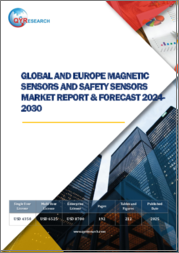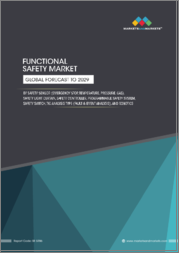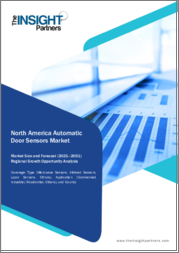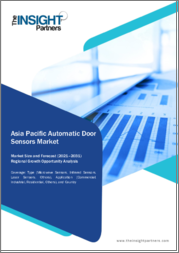
|
시장보고서
상품코드
1608102
세계의 산업용 안전 센서 시장 : 안전 유형, 센서 유형, 용도, 최종 사용자, 기술별 예측(2025-2030년)Industrial Safety Sensors Market by Safety Type (Safety Edge, Safety Laser Scanner, Safety Light Curtain), Type of Sensor (Capacitive Sensors, Inductive Sensors, Magnetic Sensors), Application, End-User, Technology - Global Forecast 2025-2030 |
||||||
산업용 안전 센서 시장의 2023년 시장 규모는 5억 9,486만 달러로 평가되었습니다. 2024년에는 6억 2,264만 달러에 이를 것으로 예측되며, 복합 연간 성장률(CAGR) 4.79%로 성장하여 2030년에는 8억 2,585만 달러에 달할 것으로 예상됩니다.
산업용 안전 센서는 산업 환경에서 안전하지 않은 상태를 감지, 측정 및 대응하기 위해 설계된 광범위한 안전 시스템에 필수적인 구성 요소입니다. 기술 포함, 사고를 방지하고 작업자 및 장비를 보호하도록 설계되었습니다. 산업용 안전 센서의 필요성은 직장 안전에 대한 규제 압력 증가와 직원의 안전과 업무 효율의 중시 증가 에 의해 계속 증가하고 있습니다. 사의 용도는 다양하게 제조업, 석유 및 가스, 자동차 등의 업계에서 기계의 안전 보호, 주변 감시, 위험 구역 검지 등에 사용되고 있습니다.용 제어 시스템 등이 있습니다. 이 시장은 산업 프로세스에서 사물 인터넷(IoT)의 통합과 같은 요인에 의해 영향을 받으며, 실시간 모니터링과 예지 보전 기능을 강화하고 있습니다. 데이터 분석을 위한 AI 기능을 갖춘 스마트 센서의 개발에 있어, 보다 적응적이고 프로액티브한 안전 솔루션을 보장합니다. 중소기업으로의 전개에 영향을 주고 있습니다. 특히 기존 시스템과의 통합이 어려움을 겪고 있습니다. 해야합니다. 기술이 자동화와 장치의 상호 연결을 지원하는 데 중요한 Industry 4.0 솔루션의 확장이라는 새로운 기회도 탄생했습니다. 확장성이 높은 솔루션의 창출을 목표로 연구개발과 파트너십에 투자해야 합니다. 투자를 하고 있습니다.
| 주요 시장 통계 | |
|---|---|
| 기준년(2023) | 5억 9,486만 달러 |
| 추정년(2024) | 6억 2,264만 달러 |
| 예측년(2030) | 8억 2,585만 달러 |
| 복합 연간 성장률(CAGR)(%) | 4.79% |
시장 역학 : 빠르게 진화하는 산업용 안전 센서 시장의 주요 시장 인사이트 공개
산업용 안전 센서 시장은 수요 및 공급의 역동적인 상호 작용에 의해 변모를 이루고 있습니다. 정교하고 새로운 비즈니스 기회를 얻는 데 도움이 될 수 있습니다. 이러한 동향을 종합적으로 파악함으로써 기업은 정치적, 지리적, 기술적, 사회적, 경제적 영역에 걸친 다양한 리스크를 경감할 수 있음과 동시에 소비자 행동과 그것 제조 비용과 구매 동향에 미치는 영향을보다 명확하게 이해할 수 있습니다.
- 시장 성장 촉진요인
- 다양한 산업에서 실시간 모니터링 및 데이터 분석 수요 증가
- 산업 및 기계 부문에서 작업자의 안전성 강화의 중시가 증가
- 인더스트리 4.0과 로봇에 의한 자동화를 추진하는 정부의 대처
- 시장 성장 억제요인
- 레거시 시스템에 센서 통합의 복잡성
- 시장 기회
- 산업 안전을 위한 무선 센서와 스마트 센서의 지속적인 개발
- 첨단 산업용 안전 센서를 통합하기 위한 제조 시설과 센서 공급자 간의 전략적 파트너십
- 시장의 과제
- 센서의 기술적 한계와 부정확성
Porter's Five Forces : 산업용 안전 센서 시장을 탐색하는 전략 도구
Porter's Five Forces Framework는 산업 안전 센서 시장 경쟁 구도를 이해하는 중요한 도구입니다. Porter's Five Forces Framework는 기업의 경쟁력을 평가하고 전략적 기회를 탐구하는 명확한 기술을 제공합니다. 이 프레임워크는 기업이 시장 내 세력도를 평가하고 신규 사업의 수익성을 판단하는 데 도움이 됩니다. 이러한 인사이트을 통해 기업은 자사의 강점을 활용하고 약점을 해결하고 잠재적인 과제를 피함으로써 보다 강인한 시장에서의 포지셔닝을 확보할 수 있습니다.
PESTLE 분석 : 산업용 안전 센서 시장에서 외부 영향을 파악
외부 거시 환경 요인은 산업 안전 센서 시장의 성과 역학을 형성하는 데 매우 중요한 역할을합니다. 정치적, 경제적, 사회적, 기술적, 법적, 환경적 요인 분석은 이러한 영향을 탐색하는 데 필요한 정보를 제공합니다. PESTLE 요인을 조사함으로써 기업은 잠재적인 위험과 기회를 더 잘 이해할 수 있습니다. 이 분석을 통해 기업은 규제, 소비자 선호, 경제 동향의 변화를 예측하고 앞으로 예상되는 적극적인 의사 결정을 할 준비가 가능합니다.
시장 점유율 분석 산업용 안전 센서 시장 경쟁 구도 파악
산업용 안전 센서 시장의 상세한 시장 점유율 분석을 통해 공급업체의 성과를 종합적으로 평가할 수 있습니다. 기업은 수익, 고객 기반, 성장률 등 주요 지표를 비교하여 경쟁 포지셔닝을 밝힐 수 있습니다. 이 분석을 통해 시장 집중, 단편화, 통합 동향을 밝혀내고 벤더들은 경쟁이 치열해지는 가운데 자사의 지위를 높이는 전략적 의사 결정을 내리는 데 필요한 지식을 얻을 수 있습니다.
FPNV 포지셔닝 매트릭스 산업용 안전 센서 시장에서 공급업체의 성능 평가
FPNV 포지셔닝 매트릭스는 산업 안전 센서 시장에서 벤더를 평가하는 중요한 도구입니다. 이 행렬을 통해 비즈니스 조직은 공급업체의 비즈니스 전략과 제품 만족도를 기준으로 평가하여 목표에 맞는 충분한 정보를 바탕으로 의사 결정을 내릴 수 있습니다. 네 가지 사분면을 통해 공급업체를 명확하고 정확하게 세분화하여 전략 목표에 가장 적합한 파트너 및 솔루션을 파악할 수 있습니다.
전략 분석 및 권장 산업용 안전 센서 시장에서 성공에 대한 길을 그립니다.
산업용 안전 센서 시장의 전략 분석은 시장에서의 프레즌스 강화를 목표로 하는 기업에 필수적인 요소입니다. 이 접근법을 통해 경쟁 구도에서 과제를 극복하고 새로운 비즈니스 기회를 활용하여 장기적인 성공을 거둘 수 있는 시스템을 구축할 수 있습니다.
이 보고서는 주요 관심 분야를 포괄하는 시장의 종합적인 분석을 제공합니다.
1. 시장 침투 : 현재 시장 환경의 상세한 검토, 주요 기업의 광범위한 데이터, 시장 도달범위 및 전반적인 영향력 평가.
2. 시장 개척도 : 신흥 시장의 성장 기회를 파악하고 기존 분야의 확장 가능성을 평가하며 미래 성장을 위한 전략적 로드맵을 제공합니다.
3. 시장 다양화 : 최근 제품 출시, 미개척 지역, 업계의 주요 진보, 시장을 형성하는 전략적 투자를 분석합니다.
4. 경쟁 평가 및 정보 : 경쟁 구도를 철저히 분석하여 시장 점유율, 사업 전략, 제품 포트폴리오, 인증, 규제 당국 승인, 특허 동향, 주요 기업의 기술 진보 등을 검증합니다.
5. 제품 개발 및 혁신 : 미래 시장 성장을 가속할 것으로 예상되는 최첨단 기술, R&D 활동, 제품 혁신을 강조합니다.
또한 이해관계자가 충분한 정보를 얻고 의사결정을 할 수 있도록 중요한 질문에 대답하고 있습니다.
1. 현재 시장 규모와 향후 성장 예측은?
2. 최고의 투자 기회를 제공하는 제품, 부문 및 지역은 어디입니까?
3. 시장을 형성하는 주요 기술 동향과 규제의 영향은?
4. 주요 벤더의 시장 점유율과 경쟁 포지션은?
5. 벤더 시장 진입, 철수 전략의 원동력이 되는 수익원과 전략적 기회는 무엇인가?
목차
제1장 서문
제2장 조사 방법
제3장 주요 요약
제4장 시장 개요
제5장 시장 인사이트
- 시장 역학
- 성장 촉진요인
- 다양한 업계에서 실시간 모니터링 및 데이터 분석 수요 증가
- 공업 및 기계부문 전체에서 노동자의 안전 강화의 중요성이 높아지고 있다
- 인더스트리 4.0과 로봇 자동화를 추진하는 정부의 대처
- 억제요인
- 센서를 레거시 시스템에 통합하는 복잡성
- 기회
- 산업 안전을 위한 무선 및 스마트 센서의 지속적인 개발
- 첨단 기술 통합을 위한 제조 시설과 센서 제공업체 간 전략적 파트너십
- 과제
- 센서의 기술적 한계와 부정확성
- 성장 촉진요인
- 시장 세분화 분석
- 안전 유형: 산업에서 직접 접촉 위험을 줄이기 위한 안전 에지 사용
- 응용: 로봇 자동화 활동에 있어서의 안전성 유지의 중요성
- Porter's Five Forces 분석
- PESTEL 분석
- 정치적
- 경제
- 사교
- 기술적
- 법률상
- 환경
제6장 산업용 안전 센서 시장 : 안전 유형별
- 세이프티 엣지
- 안전 레이저 스캐너
- 안전 라이트 커튼
- 안전 매트
제7장 산업용 안전 센서 시장 : 센서유형별
- 정전용량 센서
- 유도 센서
- 자기 센서
- 광학 센서
- 압력 감지 센서
- 초음파 센서
제8장 산업용 안전 센서 시장 : 용도별
- 액세스 제어
- 충돌 회피
- 긴급정지 시스템
- 위험 구역 감시
- 기계 보호
- 프레즌스 센싱
- 로봇의 안전성
- 차량의 안전성
제9장 산업용 안전 센서 시장 : 최종 사용자별
- 공사
- 방어
- 식품 및 음료
- 헬스케어
- 물류
- 제조업
- 광업
- 석유 및 가스
제10장 산업용 안전 센서 시장 : 기술별
- 유선
- 무선
제11장 아메리카의 산업용 안전 센서 시장
- 아르헨티나
- 브라질
- 캐나다
- 멕시코
- 미국
제12장 아시아태평양의 산업용 안전 센서 시장
- 호주
- 중국
- 인도
- 인도네시아
- 일본
- 말레이시아
- 필리핀
- 싱가포르
- 한국
- 대만
- 태국
- 베트남
제13장 유럽, 중동 및 아프리카의 산업용 안전 센서 시장
- 덴마크
- 이집트
- 핀란드
- 프랑스
- 독일
- 이스라엘
- 이탈리아
- 네덜란드
- 나이지리아
- 노르웨이
- 폴란드
- 카타르
- 러시아
- 사우디아라비아
- 남아프리카
- 스페인
- 스웨덴
- 스위스
- 터키
- 아랍에미리트(UAE)
- 영국
제14장 경쟁 구도
- 시장 점유율 분석(2023년)
- FPNV 포지셔닝 매트릭스(2023년)
- 경쟁 시나리오 분석
- KARAM Safety, 첨단 휴대용 단일 가스 감지기를 출시
- Baker Hughes, 산업 분야의 안전성과 생산성을 높이는 선진 센서 기술을 발표
- Sick은 가혹한 환경에서 신뢰성을 높이고 유지 보수 부담을 줄이는 강력한 IMG 센서를 발표했습니다.
- Pepperl Fuchs가 산업 안전을 위한 새로운 포지셔닝 솔루션 발표
- SICK, 성능 레벨 c의 선진적인 3D 비행 시간형 안전 센서를 릴리스
- Pepperl Fuchs가 BAU에서 Witt Sensoric과의 전략적 제휴 발표 2023
- 전략 분석과 제안
- 하니웰 인터내셔널 주식회사
기업 목록
- ABB Ltd.
- Amphenol Corporation
- Bosch Sensortec GmbH
- Chamberlain Group
- China Security & Fire IoT Sensing Co. Ltd.
- Datalogic SpA
- Dwyer Instruments, LLC
- Emerson Electric Co.
- GZ Cyndar Co. Ltd.
- Honeywell International Inc.
- Keyence Corporation
- Mitsubishi Electric Corporation
- Nanjing Wotian Tech. Co. Ltd.
- Olea Systems, Incorporated
- Omron Corporation
- Optex Fa Co. Ltd.
- Panasonic Corporation
- Pepperl Fuchs SE
- Pilz GmbH & Co. KG
- Pizzato Elettrica Srl
- Rockwell Automation Inc.
- SRI Electronics
- Schmersal, Inc.
- Schneider Electric SE
- Sensata Technologies, Inc.
- SensoPart Industriesensorik GmbH
- SICK AG
- Siemens AG
- SoftNoze USA Inc.
- TM Automation Instruments Co. Ltd.
- TSM Sensors srl
- Turck, Inc.
The Industrial Safety Sensors Market was valued at USD 594.86 million in 2023, expected to reach USD 622.64 million in 2024, and is projected to grow at a CAGR of 4.79%, to USD 825.85 million by 2030.
Industrial safety sensors are essential components in a broad range of safety systems, designed to detect, measure, and respond to unsafe conditions within industrial environments. The scope of these sensors encompasses technologies like proximity sensors, photoelectric sensors, and pressure sensors, among others, designed to prevent accidents and safeguard workers and equipment. The necessity for industrial safety sensors continues to rise due to increased regulatory pressures for workplace safety and the growing emphasis on employee safety and operational efficiency. Their applications are diverse, spanning industries such as manufacturing, oil & gas, and automotive, where they are used in machine safeguarding, perimeter monitoring, and hazardous area sensing. Key end-use sectors include factory automation and industrial control systems. The market is influenced by factors like the integration of the Internet of Things (IoT) in industrial processes, which enhances real-time monitoring and predictive maintenance capabilities. One potential opportunity lies in developing smart sensors with AI capabilities for data analysis, thus ensuring more adaptive and proactive safety solutions. However, market growth is challenged by high initial investments and technological complexities, impacting deployment in small to medium enterprises. Another limitation is the integration challenges within existing systems, especially for older infrastructure. Businesses should focus on innovation in sensor miniaturization, energy efficiency, and wireless communication technologies to stay competitive. Moreover, there is an emerging opportunity in expanding solutions for Industry 4.0, where sensor technologies are critical in supporting automation and the interconnectedness of devices. To capitalize on these opportunities, firms should invest in research and development and partnerships aimed at creating cost-effective, scalable solutions that cater to specific industrial requirements. The market remains competitive, characterized by players investing heavily in R&D to provide advanced functionalities and enter new segments, signaling a dynamic landscape ripe for innovation.
| KEY MARKET STATISTICS | |
|---|---|
| Base Year [2023] | USD 594.86 million |
| Estimated Year [2024] | USD 622.64 million |
| Forecast Year [2030] | USD 825.85 million |
| CAGR (%) | 4.79% |
Market Dynamics: Unveiling Key Market Insights in the Rapidly Evolving Industrial Safety Sensors Market
The Industrial Safety Sensors Market is undergoing transformative changes driven by a dynamic interplay of supply and demand factors. Understanding these evolving market dynamics prepares business organizations to make informed investment decisions, refine strategic decisions, and seize new opportunities. By gaining a comprehensive view of these trends, business organizations can mitigate various risks across political, geographic, technical, social, and economic domains while also gaining a clearer understanding of consumer behavior and its impact on manufacturing costs and purchasing trends.
- Market Drivers
- Increasing demand for real-time monitoring and data analytics in various industries
- Rising emphasis on enhancing worker safety across industrial and mechanical sectors
- Government initiatives promoting Industry 4.0 and robotic automation
- Market Restraints
- Complexity of integrating sensors into legacy systems
- Market Opportunities
- Ongoing development of wireless and smart sensors for industrial safety
- Strategic partnerships between manufacturing facilities and sensor providers for integrating advanced industrial safety sensors
- Market Challenges
- Technical limitations and inaccuracies in sensors
Porter's Five Forces: A Strategic Tool for Navigating the Industrial Safety Sensors Market
Porter's five forces framework is a critical tool for understanding the competitive landscape of the Industrial Safety Sensors Market. It offers business organizations with a clear methodology for evaluating their competitive positioning and exploring strategic opportunities. This framework helps businesses assess the power dynamics within the market and determine the profitability of new ventures. With these insights, business organizations can leverage their strengths, address weaknesses, and avoid potential challenges, ensuring a more resilient market positioning.
PESTLE Analysis: Navigating External Influences in the Industrial Safety Sensors Market
External macro-environmental factors play a pivotal role in shaping the performance dynamics of the Industrial Safety Sensors Market. Political, Economic, Social, Technological, Legal, and Environmental factors analysis provides the necessary information to navigate these influences. By examining PESTLE factors, businesses can better understand potential risks and opportunities. This analysis enables business organizations to anticipate changes in regulations, consumer preferences, and economic trends, ensuring they are prepared to make proactive, forward-thinking decisions.
Market Share Analysis: Understanding the Competitive Landscape in the Industrial Safety Sensors Market
A detailed market share analysis in the Industrial Safety Sensors Market provides a comprehensive assessment of vendors' performance. Companies can identify their competitive positioning by comparing key metrics, including revenue, customer base, and growth rates. This analysis highlights market concentration, fragmentation, and trends in consolidation, offering vendors the insights required to make strategic decisions that enhance their position in an increasingly competitive landscape.
FPNV Positioning Matrix: Evaluating Vendors' Performance in the Industrial Safety Sensors Market
The Forefront, Pathfinder, Niche, Vital (FPNV) Positioning Matrix is a critical tool for evaluating vendors within the Industrial Safety Sensors Market. This matrix enables business organizations to make well-informed decisions that align with their goals by assessing vendors based on their business strategy and product satisfaction. The four quadrants provide a clear and precise segmentation of vendors, helping users identify the right partners and solutions that best fit their strategic objectives.
Strategy Analysis & Recommendation: Charting a Path to Success in the Industrial Safety Sensors Market
A strategic analysis of the Industrial Safety Sensors Market is essential for businesses looking to strengthen their global market presence. By reviewing key resources, capabilities, and performance indicators, business organizations can identify growth opportunities and work toward improvement. This approach helps businesses navigate challenges in the competitive landscape and ensures they are well-positioned to capitalize on newer opportunities and drive long-term success.
Key Company Profiles
The report delves into recent significant developments in the Industrial Safety Sensors Market, highlighting leading vendors and their innovative profiles. These include ABB Ltd., Amphenol Corporation, Bosch Sensortec GmbH, Chamberlain Group, China Security & Fire IoT Sensing Co., Ltd., Datalogic S.p.A., Dwyer Instruments, LLC, Emerson Electric Co., GZ Cyndar Co., Ltd., Honeywell International Inc., Keyence Corporation, Mitsubishi Electric Corporation, Nanjing Wotian Tech. Co., Ltd., Olea Systems, Incorporated, Omron Corporation, Optex Fa Co., Ltd., Panasonic Corporation, Pepperl+Fuchs SE, Pilz GmbH & Co. KG, Pizzato Elettrica S.r.l., Rockwell Automation Inc., S.R.I Electronics, Schmersal, Inc., Schneider Electric SE, Sensata Technologies, Inc., SensoPart Industriesensorik GmbH, SICK AG, Siemens AG, SoftNoze USA Inc., TM Automation Instruments Co., Ltd., TSM Sensors s.r.l., and Turck, Inc..
Market Segmentation & Coverage
This research report categorizes the Industrial Safety Sensors Market to forecast the revenues and analyze trends in each of the following sub-markets:
- Based on Safety Type, market is studied across Safety Edge, Safety Laser Scanner, Safety Light Curtain, and Safety Mat.
- Based on Type of Sensor, market is studied across Capacitive Sensors, Inductive Sensors, Magnetic Sensors, Optical Sensors, Pressure-sensitive Sensors, and Ultrasonic Sensors.
- Based on Application, market is studied across Access Control, Collision Avoidance, Emergency Stop Systems, Hazardous Area Monitoring, Machine Guarding, Presence Sensing, Robotics Safety, and Vehicle Safety.
- Based on End-User, market is studied across Construction, Defense, Food & Beverages, Healthcare, Logistics, Manufacturing, Mining, and Oil & Gas.
- Based on Technology, market is studied across Wired and Wireless.
- Based on Region, market is studied across Americas, Asia-Pacific, and Europe, Middle East & Africa. The Americas is further studied across Argentina, Brazil, Canada, Mexico, and United States. The United States is further studied across California, Florida, Illinois, New York, Ohio, Pennsylvania, and Texas. The Asia-Pacific is further studied across Australia, China, India, Indonesia, Japan, Malaysia, Philippines, Singapore, South Korea, Taiwan, Thailand, and Vietnam. The Europe, Middle East & Africa is further studied across Denmark, Egypt, Finland, France, Germany, Israel, Italy, Netherlands, Nigeria, Norway, Poland, Qatar, Russia, Saudi Arabia, South Africa, Spain, Sweden, Switzerland, Turkey, United Arab Emirates, and United Kingdom.
The report offers a comprehensive analysis of the market, covering key focus areas:
1. Market Penetration: A detailed review of the current market environment, including extensive data from top industry players, evaluating their market reach and overall influence.
2. Market Development: Identifies growth opportunities in emerging markets and assesses expansion potential in established sectors, providing a strategic roadmap for future growth.
3. Market Diversification: Analyzes recent product launches, untapped geographic regions, major industry advancements, and strategic investments reshaping the market.
4. Competitive Assessment & Intelligence: Provides a thorough analysis of the competitive landscape, examining market share, business strategies, product portfolios, certifications, regulatory approvals, patent trends, and technological advancements of key players.
5. Product Development & Innovation: Highlights cutting-edge technologies, R&D activities, and product innovations expected to drive future market growth.
The report also answers critical questions to aid stakeholders in making informed decisions:
1. What is the current market size, and what is the forecasted growth?
2. Which products, segments, and regions offer the best investment opportunities?
3. What are the key technology trends and regulatory influences shaping the market?
4. How do leading vendors rank in terms of market share and competitive positioning?
5. What revenue sources and strategic opportunities drive vendors' market entry or exit strategies?
Table of Contents
1. Preface
- 1.1. Objectives of the Study
- 1.2. Market Segmentation & Coverage
- 1.3. Years Considered for the Study
- 1.4. Currency & Pricing
- 1.5. Language
- 1.6. Stakeholders
2. Research Methodology
- 2.1. Define: Research Objective
- 2.2. Determine: Research Design
- 2.3. Prepare: Research Instrument
- 2.4. Collect: Data Source
- 2.5. Analyze: Data Interpretation
- 2.6. Formulate: Data Verification
- 2.7. Publish: Research Report
- 2.8. Repeat: Report Update
3. Executive Summary
4. Market Overview
5. Market Insights
- 5.1. Market Dynamics
- 5.1.1. Drivers
- 5.1.1.1. Increasing demand for real-time monitoring and data analytics in various industries
- 5.1.1.2. Rising emphasis on enhancing worker safety across industrial and mechanical sectors
- 5.1.1.3. Government initiatives promoting Industry 4.0 and robotic automation
- 5.1.2. Restraints
- 5.1.2.1. Complexity of integrating sensors into legacy systems
- 5.1.3. Opportunities
- 5.1.3.1. Ongoing development of wireless and smart sensors for industrial safety
- 5.1.3.2. Strategic partnerships between manufacturing facilities and sensor providers for integrating advanced industrial safety sensors
- 5.1.4. Challenges
- 5.1.4.1. Technical limitations and inaccuracies in sensors
- 5.1.1. Drivers
- 5.2. Market Segmentation Analysis
- 5.2.1. Safety Type: Use of safety edges for direct contact risk mitigation in industries
- 5.2.2. Application: Importance of maintaining safety in robotic automation activities
- 5.3. Porter's Five Forces Analysis
- 5.3.1. Threat of New Entrants
- 5.3.2. Threat of Substitutes
- 5.3.3. Bargaining Power of Customers
- 5.3.4. Bargaining Power of Suppliers
- 5.3.5. Industry Rivalry
- 5.4. PESTLE Analysis
- 5.4.1. Political
- 5.4.2. Economic
- 5.4.3. Social
- 5.4.4. Technological
- 5.4.5. Legal
- 5.4.6. Environmental
6. Industrial Safety Sensors Market, by Safety Type
- 6.1. Introduction
- 6.2. Safety Edge
- 6.3. Safety Laser Scanner
- 6.4. Safety Light Curtain
- 6.5. Safety Mat
7. Industrial Safety Sensors Market, by Type of Sensor
- 7.1. Introduction
- 7.2. Capacitive Sensors
- 7.3. Inductive Sensors
- 7.4. Magnetic Sensors
- 7.5. Optical Sensors
- 7.6. Pressure-sensitive Sensors
- 7.7. Ultrasonic Sensors
8. Industrial Safety Sensors Market, by Application
- 8.1. Introduction
- 8.2. Access Control
- 8.3. Collision Avoidance
- 8.4. Emergency Stop Systems
- 8.5. Hazardous Area Monitoring
- 8.6. Machine Guarding
- 8.7. Presence Sensing
- 8.8. Robotics Safety
- 8.9. Vehicle Safety
9. Industrial Safety Sensors Market, by End-User
- 9.1. Introduction
- 9.2. Construction
- 9.3. Defense
- 9.4. Food & Beverages
- 9.5. Healthcare
- 9.6. Logistics
- 9.7. Manufacturing
- 9.8. Mining
- 9.9. Oil & Gas
10. Industrial Safety Sensors Market, by Technology
- 10.1. Introduction
- 10.2. Wired
- 10.3. Wireless
11. Americas Industrial Safety Sensors Market
- 11.1. Introduction
- 11.2. Argentina
- 11.3. Brazil
- 11.4. Canada
- 11.5. Mexico
- 11.6. United States
12. Asia-Pacific Industrial Safety Sensors Market
- 12.1. Introduction
- 12.2. Australia
- 12.3. China
- 12.4. India
- 12.5. Indonesia
- 12.6. Japan
- 12.7. Malaysia
- 12.8. Philippines
- 12.9. Singapore
- 12.10. South Korea
- 12.11. Taiwan
- 12.12. Thailand
- 12.13. Vietnam
13. Europe, Middle East & Africa Industrial Safety Sensors Market
- 13.1. Introduction
- 13.2. Denmark
- 13.3. Egypt
- 13.4. Finland
- 13.5. France
- 13.6. Germany
- 13.7. Israel
- 13.8. Italy
- 13.9. Netherlands
- 13.10. Nigeria
- 13.11. Norway
- 13.12. Poland
- 13.13. Qatar
- 13.14. Russia
- 13.15. Saudi Arabia
- 13.16. South Africa
- 13.17. Spain
- 13.18. Sweden
- 13.19. Switzerland
- 13.20. Turkey
- 13.21. United Arab Emirates
- 13.22. United Kingdom
14. Competitive Landscape
- 14.1. Market Share Analysis, 2023
- 14.2. FPNV Positioning Matrix, 2023
- 14.3. Competitive Scenario Analysis
- 14.3.1. KARAM Safety launches advanced portable single gas detector
- 14.3.2. Baker Hughes Unveils Advanced Sensor Technologies to Boost Safety and Productivity in Industrial Sectors
- 14.3.3. Sick debuts robust IMG sensor to enhance reliability and reduce maintenance in harsh conditions
- 14.3.4. Pepperl+Fuchs Introduces New Positioning Solutions for Industrial Safety
- 14.3.5. SICK Releases Advanced 3D Time-of-Flight Safety Sensor with Performance Level c
- 14.3.6. Pepperl+Fuchs Announced Strategic Collaboration with Witt Sensoric at BAU 2023
- 14.4. Strategy Analysis & Recommendation
- 14.4.1. Honeywell International Inc.
Companies Mentioned
- 1. ABB Ltd.
- 2. Amphenol Corporation
- 3. Bosch Sensortec GmbH
- 4. Chamberlain Group
- 5. China Security & Fire IoT Sensing Co., Ltd.
- 6. Datalogic S.p.A.
- 7. Dwyer Instruments, LLC
- 8. Emerson Electric Co.
- 9. GZ Cyndar Co., Ltd.
- 10. Honeywell International Inc.
- 11. Keyence Corporation
- 12. Mitsubishi Electric Corporation
- 13. Nanjing Wotian Tech. Co., Ltd.
- 14. Olea Systems, Incorporated
- 15. Omron Corporation
- 16. Optex Fa Co., Ltd.
- 17. Panasonic Corporation
- 18. Pepperl+Fuchs SE
- 19. Pilz GmbH & Co. KG
- 20. Pizzato Elettrica S.r.l.
- 21. Rockwell Automation Inc.
- 22. S.R.I Electronics
- 23. Schmersal, Inc.
- 24. Schneider Electric SE
- 25. Sensata Technologies, Inc.
- 26. SensoPart Industriesensorik GmbH
- 27. SICK AG
- 28. Siemens AG
- 29. SoftNoze USA Inc.
- 30. TM Automation Instruments Co., Ltd.
- 31. TSM Sensors s.r.l.
- 32. Turck, Inc.



















